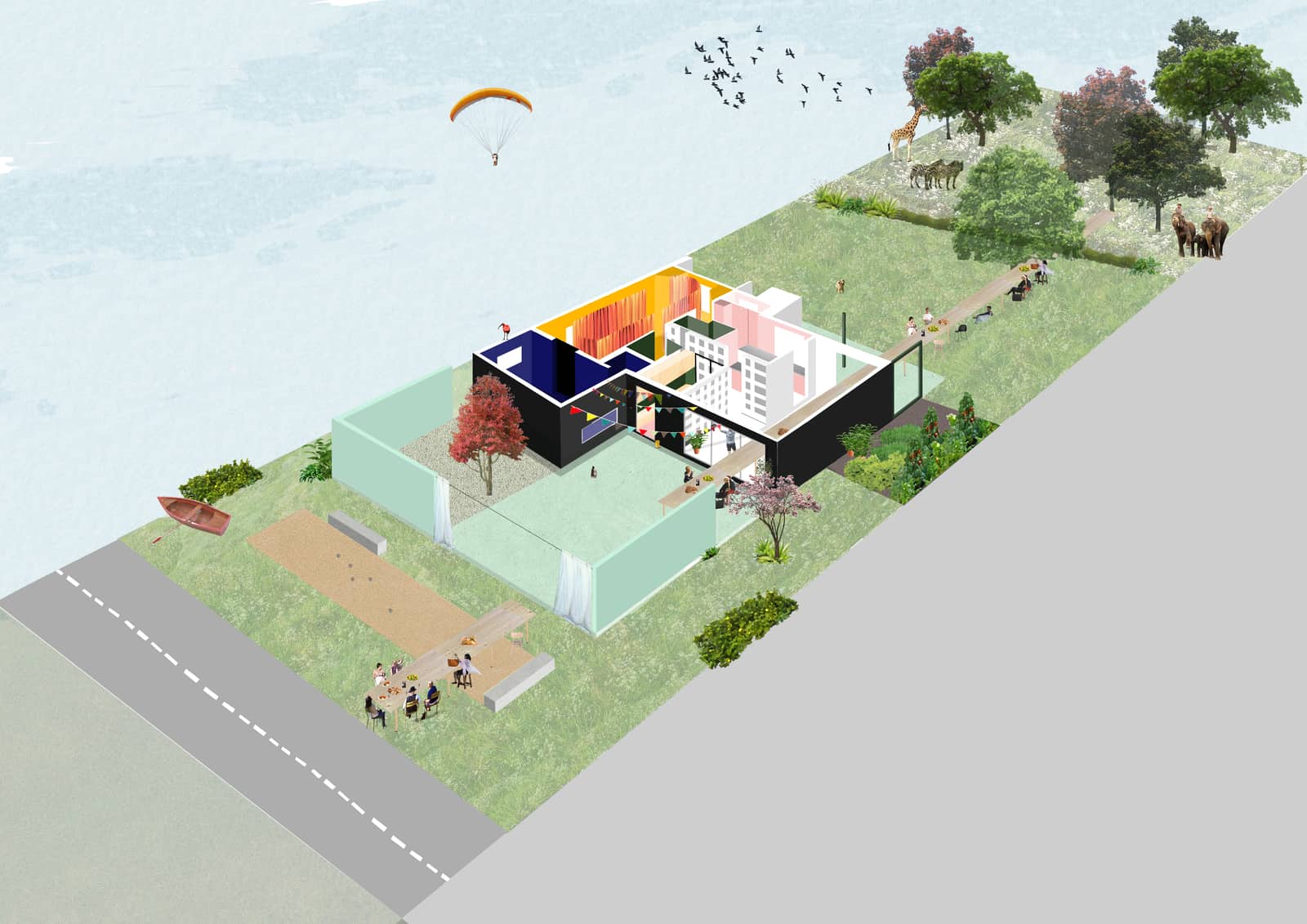How Two Domestic Gardens Challenge the Contemporary Landscape Imagination
Downloads
DOI:
https://doi.org/10.7480/spool.2020.1.5481Keywords:
landscape architecture, landscape imagination, landscape metropolis, garden complex, garden design, domestic gardens, everyday gardens, hybridity, scalar paradox, complex dynamics, FlandersAbstract
Belonging to the small-scale and private sphere, gardens are usually omitted from urban and regional landscape plans. Yet, we argue that the assemblage of everyday gardens – the garden complex – is an inherent component of the landscape metropolis that holds the potential to become a powerful landscape agency. This potential is enclosed, among others, within three particular qualities: hybridity, scalar paradoxes, and complex dynamics. Practicing these qualities as concepts for landscape design and analysis helps to expand the imaginaries of everyday gardens to more purposefully reflect and negotiate the condition of the landscape metropolis. By means of two case studies – two domestic gardens – we demonstrate that designing with hybridity entails versatility, simultaneity, and multiplicity, thereby engendering a richness of meaning and experiences. This pluralism is also inherent in the scalar paradoxes we observed. Cross-scalar interactions evoke design implications that transcend the confines of the private plot, surpassing individual, human gain, and making individual gardens enter into dialogue with each other and with their surroundings. Lastly, by working with an enlarged set of complex dynamics, the two case studies prove that a garden can be a driver of change and innovation, and thereby a valuable source of resilience.
How to Cite
Published
License
Copyright (c) 2020 Bieke Cattoor, Valerie Dewaelheyns

This work is licensed under a Creative Commons Attribution 4.0 International License.

References
Anstey, G. (2009). Unplanned rural living and its policy implications: Some findings from Bundaberg, Australia. Land Use Policy, 26(2), 401–413. https://doi.org/10.1016/j.landusepol.2008.05.002
Antrop, M. (1998). Landscape change: Plan or chaos? Landscape and Urban Planning, 41(3–4), 155–161. https://doi.org/10.1016/s0169-2046(98)00068-1
Brenner, N., & Schmidt, C. (2011). Planetary urbanization. In M. Gandy (Ed.), Urban Constellations. Berlin: Jovis.
Cameron, R. W. F., Blanuša, T., Taylor, J. E., Salisbury, A., Halstead, A. J., Henricot, B., & Thompson, K. (2012). The domestic garden: Its contribution to urban green infrastructure. Urban Forestry & Urban Greening, 11, 129-137.
Cattoor, B. (2015). Designerly mapping practices at the crossroads of cartography and urbanism: A processual account of three re-cartographies of southwest Flanders. Environment and Planning A, 47(6), 1283–1297.
Cattoor, B., & Perkins, C. (2014). Re-cartographies of Landscape: New Narratives in Architectural Atlases. The Cartographic Journal, 51(2), 166–178. https://doi.org/10.1179/1743277413y.0000000076
Colding, J., Lundberg, J., & Folke, C. (2006). Incorporating green-area user groups in urban ecosystem management. AMBIO: A Journal of the Human Environment, 35, 237-244.
Corboz, A. (1983) Le territoire comme palimpseste [The territory as palimpsest]. Diogène, 121, 14–35.
Corijn, E., Loeckx, A., & Persyn, F. (2015). Metropolitan landscapes: 9 + 1 maal anders kijken. In J. Mabilde, E.Vanempten, S. Devoldere & C. Oosterlynck (Eds.), Metropolitan Landscapes. Brussels.
de Wit, S., & Dekker, A. (2020). the Garden in the Landscape Metropolis. SPOOL, 7(1), 3-8. doi:10.7480/spool.2020.1.5477
Dewaelheyns, V., Kerselaers, E., & Rogge, E. (2016). A toolbox for garden governance. Land Use Policy, 51, 191-205.
Dewaelheyns, V., Rogge, E., & Gulinck, H. (2014). Putting domestic gardens on the agenda using empirical spatial data: The case of Flanders. Applied Geography, 50, 132-143.
Francis, M., & Hester, R.T. Jr. (1990). The Meaning of Gardens: Idea, Place, and Action. Cambridge: MIT Press.
Jakobsson, A., & Dewaelheyns, V. (2018). Contemporary interpretation of the meaning and heritage of early 20th century private gardens: From an historical reflection to a future outlook in planning. Urban Forestry & Urban Greening, 30, 210-219.
Gehl, J. (1987). Life Between Buildings. New York: Van Nostrand Reinhold Company.
Gill, S. E., Handley, J. F., Ennos, A. R., Pauleit, S., Theuray, N., & Lindley, S. J., (2008). Characterising the urban environment of UK cities and towns: A template for landscape planning. Landscape and urban planning, 87, 210-222.
Goddard, M. A., Dougill, A. J., & Benton, T. G., 2013. Why garden for wildlife? Social and ecological drivers, motivations and barriers for biodiversity management in residential landscapes. Ecological Economics 86, 258-273.
Mathieu, R., Freeman, C., & Aryal, J. (2007). Mapping private gardens in urban areas using object- oriented techniques and very high-resolution satellite imagery. Landscape and urban planning, 81, 179-192.
Miller, M. (1993). The Garden as Art. Albany, NY: SUNY Press.
Moulaert, F. and Van Dyck, B. (2011). The garden as a metaphor of resilience. In V. Dewaelheyns, K. Bomans and H. Gulinck (Eds), The Powerful Garden: Emerging Views on the Garden Complex. Antwerp; Apeldoorn: Garant Uitgevers N V.
Phillips, M., Page, S., Saratsi, E., Tansey, K., & Moore, K. (2008). Diversity, scale and green landscapes in the gentrification process: Traversing ecological and social science perspectives. Applied Geography, 28, 54-76.
Pisman, A., Vanacker, S., Willems, P., Engelen, G. & Poelmans, L. (Eds.). (2018). Ruimterapport Vlaanderen (RURA). Een ruimtelijke analyse van Vlaanderen. (Space report Flanders. A spatial analysis of Flanders) Brussel: departement Omgeving.
Primdahl, J. (2010). Globalisation and the local agricultural landscape: current change patterns and public policy interventions. In Globalisation and agricultural landscapes (pp. 149-167). Cambridge University Press.
Qviström, M. (2007). Landscapes out of order: studying the inner urban fringe beyond the rural-urban divide. Geografiska Annaler: Series B, Human Geography, 89, 269-282.
Tratalos, J., Fuller, R.A., Warren, P.H., Davies, R.G. & Gaston, K.J. (2007). Urban form, biodiversity potential and ecosystem services. Landscape and Urban Planning, 83(4), 308–317.
Tschumi, B. (2012). Importing the city into architecture: interview by A. Eisenschmidt in New York, 13 July 2011, Architectural Design, 82(5), 130–135.
Tzoulas, K., Korpela, K., Venn, S., Yli-Pelkonen, V., Kaźmierczak, A., Niemela, J. and James, P. (2007). Promoting ecosystem and human health in urban areas using green infrastructure: A literature review. Landscape and Urban Planning, 81(3), 167–178.
Van Delm, A. & Gulinck, H. (2011). Classification and quantification of green in the expanding urban and semi-urban complex: Application of detailed field data and IKONOS-imagery. Ecological Indicators, 11, 52-60.



